A Numerical Simulation of Radiation Chemistry for Controlling the Oxidising Environment in Water-Cooled Nuclear Power Reactors
Abstract
:1. Introduction
2. Materials and Methods
3. Results
3.1. Main Oxidant Production versus Radiation Composition
3.1.1. Neutral Water
3.1.2. Alkaline Aqueous Solution
3.2. Effectiveness of Hydrogen Addition in Suppressing Production of Stable Oxidants
4. Discussion
4.1. Significance of Reactions
4.2. Key Reactions Contributing to Production of Oxidants
5. Conclusions
Funding
Institutional Review Board Statement
Informed Consent Statement
Acknowledgments
Conflicts of Interest
References
- Kawamura, H.; Shoda, Y.; Terachi, T.; Katsumura, Y.; Uchida, S.; Mizuno, T.; Muroya, Y.; Tsuzuki, Y.; Umehara, R.; Hirano, H.; et al. PWR secondary water chemistry guidelines in Japan—Purpose and technical background. Prog. Nucl. Energy 2019, 114, 121–137. [Google Scholar] [CrossRef]
- Takagi, J.; Mincher, B.J.; Yamaguchi, M.; Katsumura, Y. Radiation chemistry in nuclear engineering. In Charged Particle and Photon Interactions with Matter. Recent Advances, Applications, and Interfaces; Hatano, Y., Katsumura, Y., Mozumder, A., Eds.; CRC Press Taylor & Francis Group: Boca Raton, FL, USA; London, UK; New York, NY, USA,, 2011; pp. 960–1023. [Google Scholar]
- Buxton, G.V. The radiation chemistry of liquid water. In Charged Particle and Photon Interactions with Matter; Hatano, Y., Mozumder, A., Eds.; Marcel Dekker: New York, NY, USA, 2003; pp. 331–364. [Google Scholar]
- Wada, Y.; Watanabe, A.; Tachibana, M.; Ishida, K.; Uetake, N.; Uchida, S.; Akamine, K.; Sambongi, M.; Suzuki, S.; Ishigure, K. Effects of hydrogen peroxide on intergranular stress corrosion cracking of stainless steel in high temperature water, (IV). J. Nucl. Sci. Technol. 2012, 38, 183–192. [Google Scholar] [CrossRef]
- Raiman, S.S.; Was, G.S. Accelerated corrosion and oxide dissolution in 316L stainless steel irradiated in situ in high temperature water. J. Nucl. Mater. 2017, 493, 207–218. [Google Scholar] [CrossRef]
- Doyle, P.; Sun, K.; Snead, L.; Katoh, Y.; Bartels, D.; Zinkle, S.; Raiman, S. The effects of neutron and ionizing irradiation on the aqueous corrosion of SiC. J. Nucl. Mater. 2020, 536, 152190. [Google Scholar] [CrossRef]
- Ibe, E.; Uchida, S. A water radiolysis model in a circulating flow system with a boiling region and its application to hydrogen alternate, water chemistry of boiling water reactors. Nucl. Sci. Eng. 1985, 90, 140–157. [Google Scholar] [CrossRef]
- Sunaryo, G.R.; Katsumura, Y.; Ishigure, K. Radiolysis of water at elevated temperatures—III. Simulation of radiolytic products at 25 and 250 °C under irradiation with γ-rays and fast neutrons. Radiat. Phys. Chem. 1995, 45, 703–714. [Google Scholar] [CrossRef]
- Christensen, H. Remodeling of the oxidant species during radiolysis of high-temperature water in a pressurized water reactor. Nucl. Technol. 1995, 109, 373–382. [Google Scholar] [CrossRef]
- Swiatla-Wojcik, D.; Buxton, G.V. Modelling Radiolysis of Water Coolant under Operating Conditions. In Proceedings of the 23rd Miller Conference in Radiation Chemistry, Białowieża, Poland, 6–12 September 2003. [Google Scholar]
- Takiguchi, H.; Ullberg, M.; Uchida, S. Optimization of dissolved hydrogen concentration for control of primary coolant radiolysis in pressurized water reactors. J. Nucl. Sci. Technol. 2004, 41, 601–609. [Google Scholar] [CrossRef]
- Bartels, D.M.; Henshaw, J.; Sims, H.E. Modeling the critical hydrogen concentration in the AECL test reactor. Radiat. Phys. Chem. 2013, 82, 16–24. [Google Scholar] [CrossRef]
- Lertnaisat, P.; Katsumura, Y.; Mukai, S.; Umehara, R.; Shimizu, Y.; Suzuki, M. Primary yields and reaction sets with corresponding rate constants for computer simulation of water radiolysis at elevated temperature. J. Nucl. Sci. Technol. 2016, 53, 1816–1823. [Google Scholar] [CrossRef]
- Swiatla-Wojcik, D. Hybrid method for numerical modelling of LWR coolant chemistry. Radiat. Phys. Chem. 2016, 127, 236–242. [Google Scholar] [CrossRef]
- Christensen, H. Fundamental aspects of water coolant radiolysis. In SKI Report 2006:16; Swedish Nuclear Power Inspectorate: Nyköping, Sweden, 2006. [Google Scholar]
- Elliot, A.J.; Bartels, D.M. The reaction set, rate constants and g-values for the simulation of the radiolysis of light water over the range 20 to 350 °C based on information available in 2008. In Report AECL-153-127160-450-001; Chalk River Laboratories: Chalk River, ON, Canada, 2009. [Google Scholar]
- Swiatla-Wojcik, D.; Buxton, G.V. On the possible role of the reaction •H + H2O → H2 + •OH in the radiolysis of water at high temperatures. Radiat. Phys. Chem. 2005, 74, 210–219. [Google Scholar] [CrossRef]
- Bartels, D.M. Comment on the possible role of the reaction •H + H2O → H2 + •OH in the radiolysis of water at high temperatures. Radiat. Phys. Chem. 2009, 78, 191–194. [Google Scholar] [CrossRef]
- Swiatla-Wojcik, D.; Buxton, G.V. Reply to comment on the possible role of the reaction •H + H2O → H2 + •OH in the radiolysis of water at high temperatures. Radiat. Phys. Chem. 2010, 79, 52–56. [Google Scholar] [CrossRef]
- Sanguanmith, S.; Muroya, Y.; Meesungnoen, J.; Lin, M.; Katsumura, Y.; Mirsaleh Kohan, L.; Guzonas, D.A.; Stuart, C.R.; Jay-Gerin, J.-P. Low-linear energy transfer radiolysis of liquid water at elevated temperatures up to 350 °C: Monte-Carlo simulations. Chem. Phys. Lett. 2011, 508, 224–230. [Google Scholar] [CrossRef]
- Alcorn, C.D.; Brodovitch, J.-C.; Percival, P.W.; Smith, M.; Ghandi, K. Kinetics of the reaction between H and superheated water probed with muonium. Chem. Phys. 2014, 435, 29–39. [Google Scholar] [CrossRef]
- Muroya, Y.; Yamashita, S.; Lertnaisat, P.; Sanguanmith, S.; Meesungnoen, J.; Jay-Gerin, J.-P.; Katsumura, Y. Rate constant for the H• + H2O → •OH + H2 reaction at elevated temperatures measured by pulse radiolysis. Phys. Chem. Chem. Phys. 2017, 19, 30834–30841. [Google Scholar] [CrossRef] [PubMed]
- Kazmierczak, L.; Szala-Bilnik, J.; Wolszczak, M.; Swiatla-Wojcik, D. Temperature dependence of the rate constant for hydrogen atom reaction with Cl2−• in water by pulse radiolysis of aqueous HCl solution. Radiat. Phys. Chem. 2015, 117, 7–11. [Google Scholar] [CrossRef]
- Swiatla-Wojcik, D. Modelling spur chemistry for alkaline and acidic water at high temperatures. Res. Chem. Intermed. 2009, 35, 519–530. [Google Scholar] [CrossRef]
- Ichikawa, N.; Takagi, J. Precise evaluation of corrosion environments of structural materials under complex water flow conditions (II). J. Nucl. Sci. Technol. 2003, 40, 941–950. [Google Scholar] [CrossRef]
- Swiatla-Wojcik, D. Water-structure based mechanistic view on the bimolecular decay of the hydrated electron. Chem. Phys. Lett. 2015, 641, 51–56. [Google Scholar] [CrossRef]
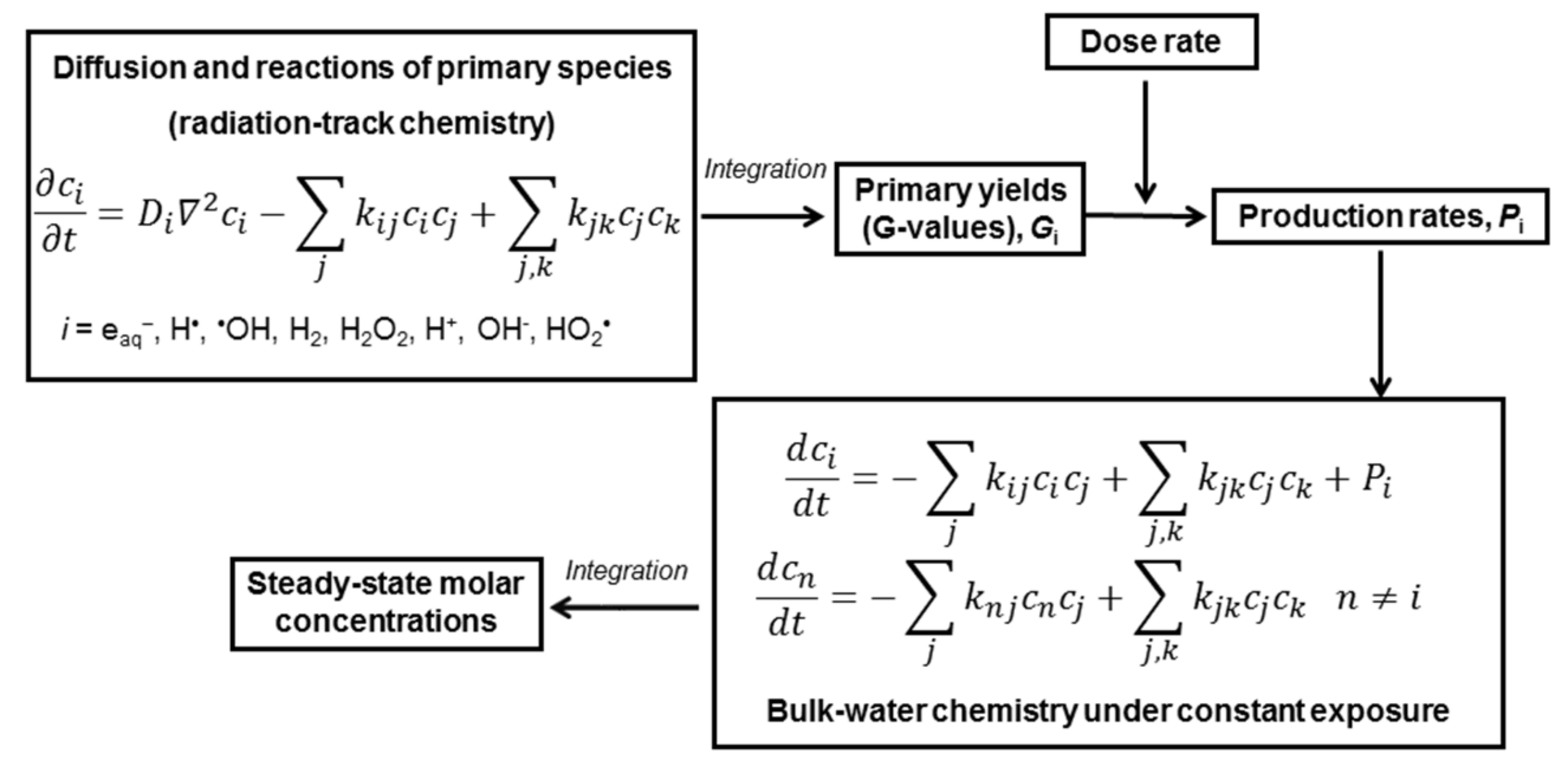
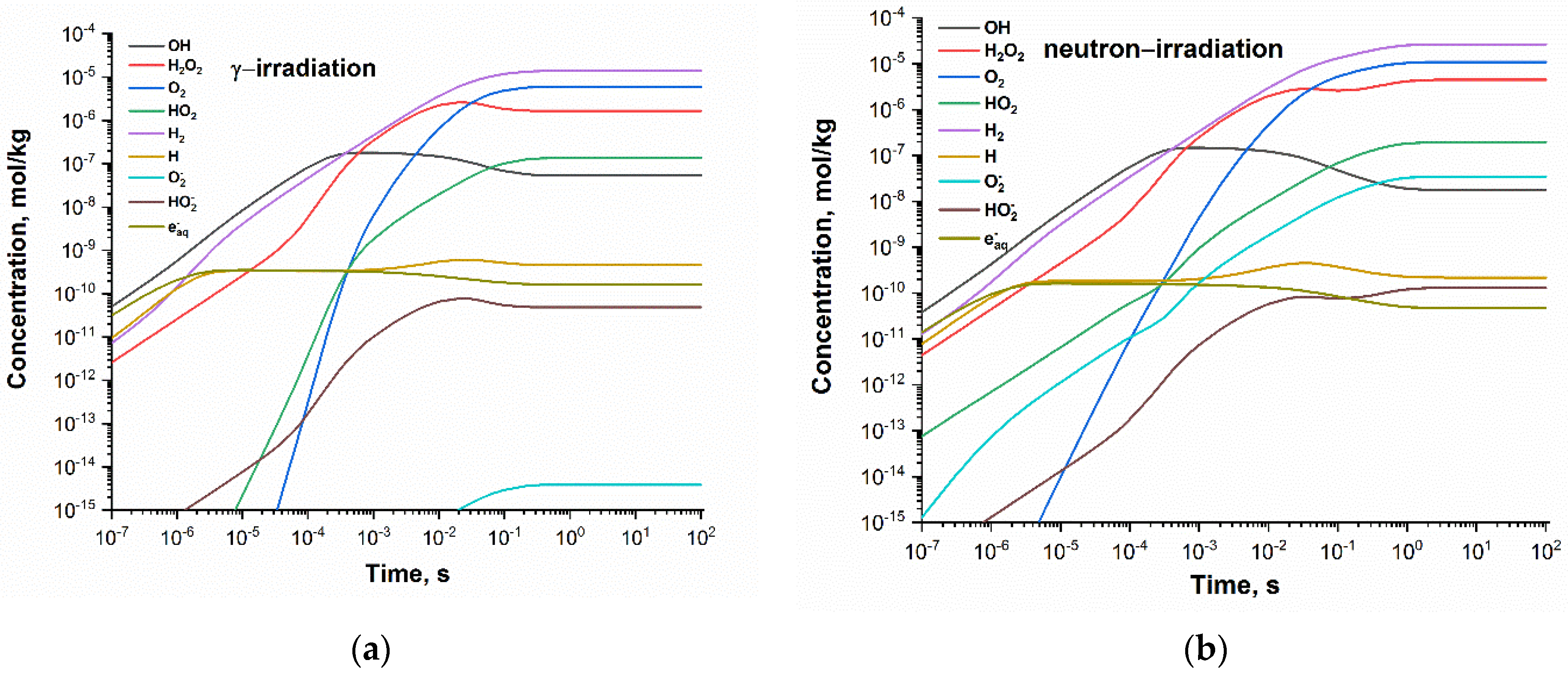
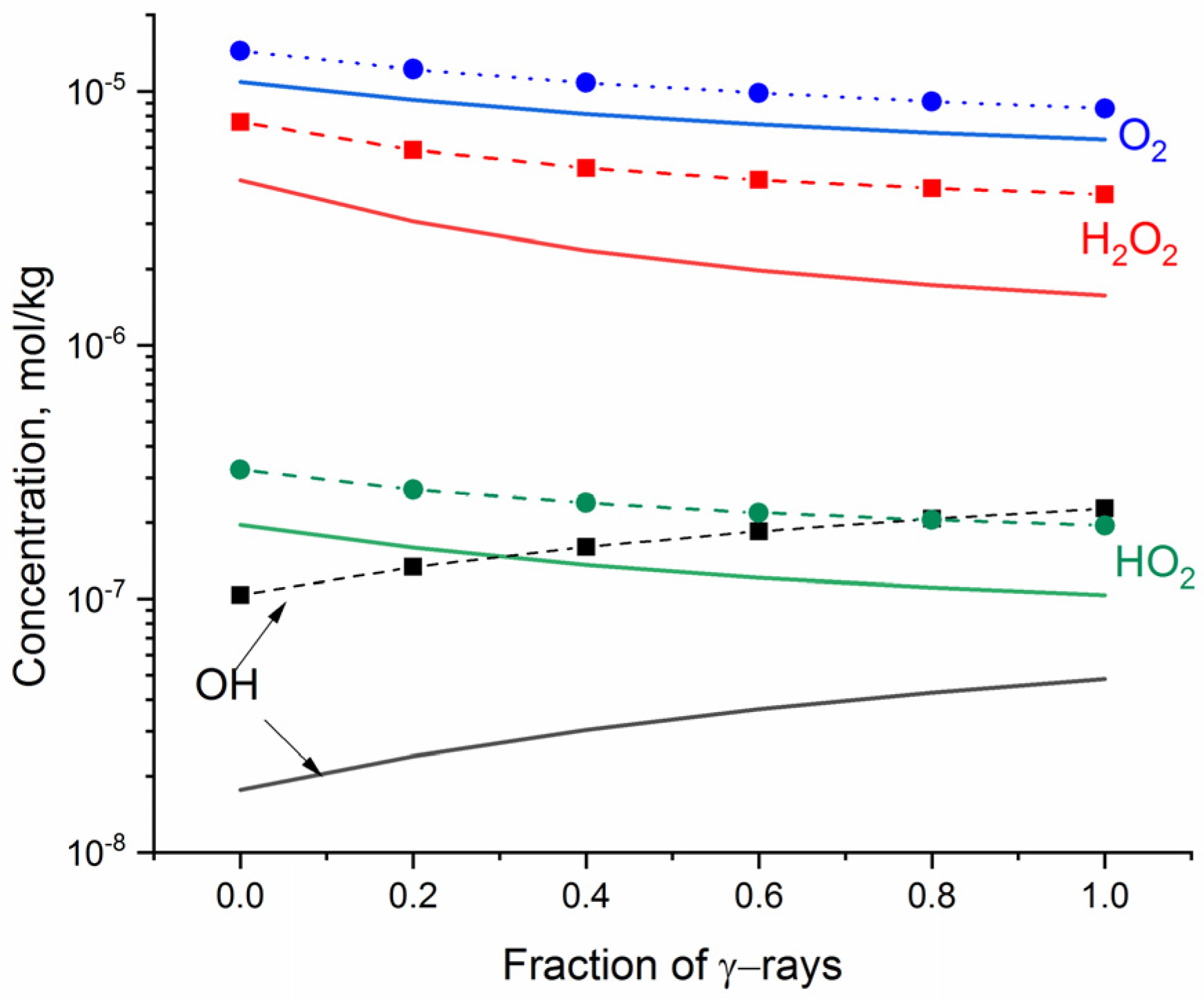



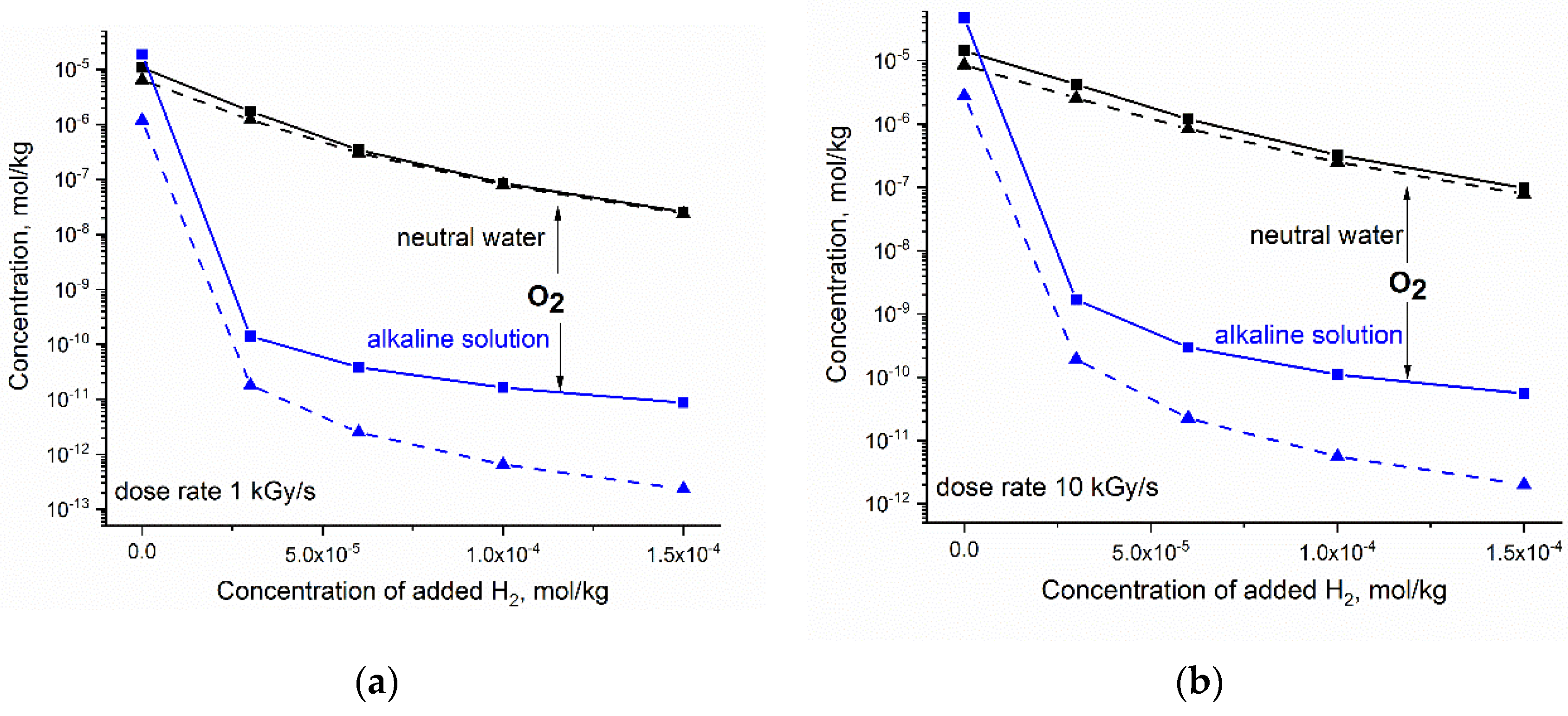


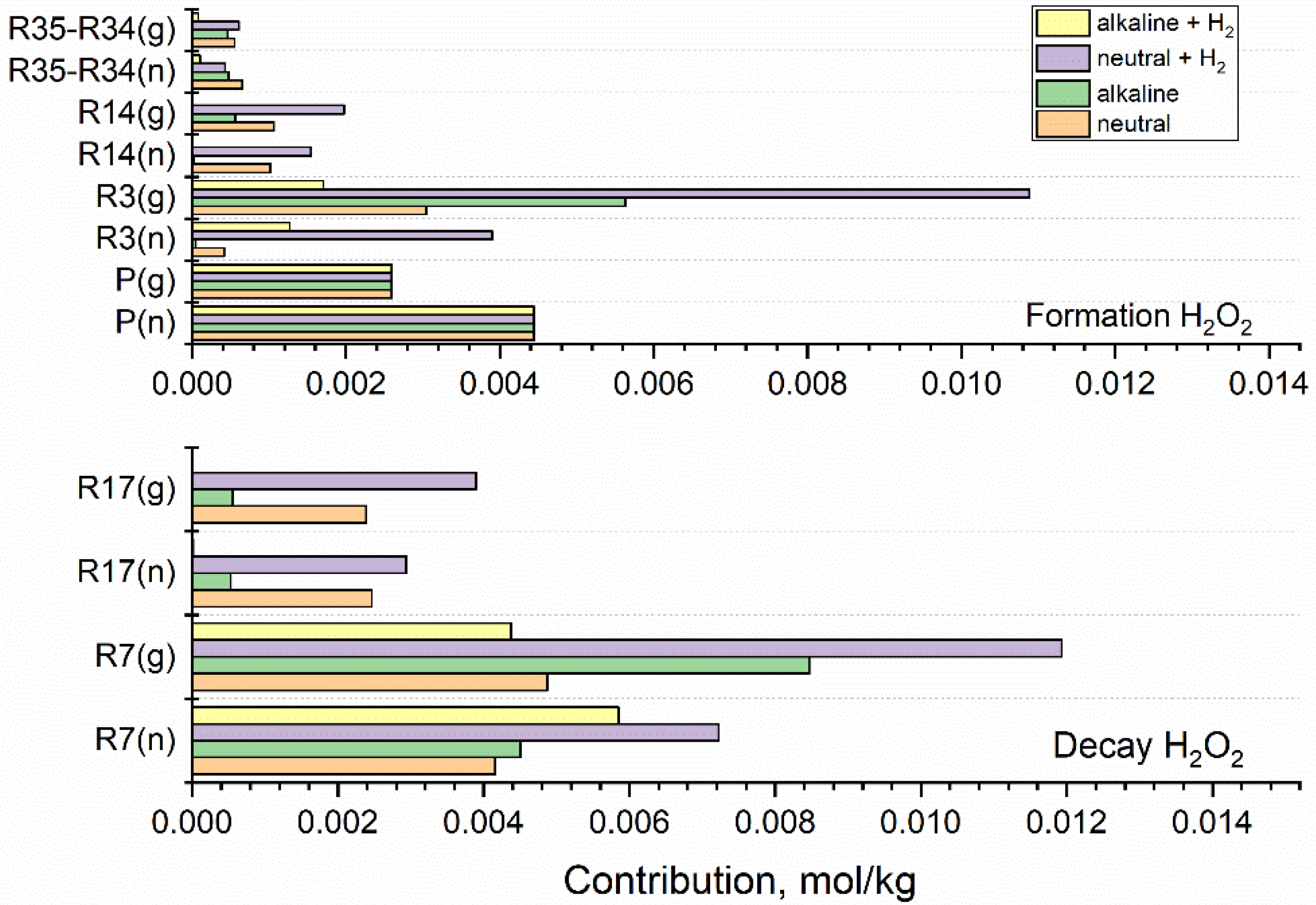
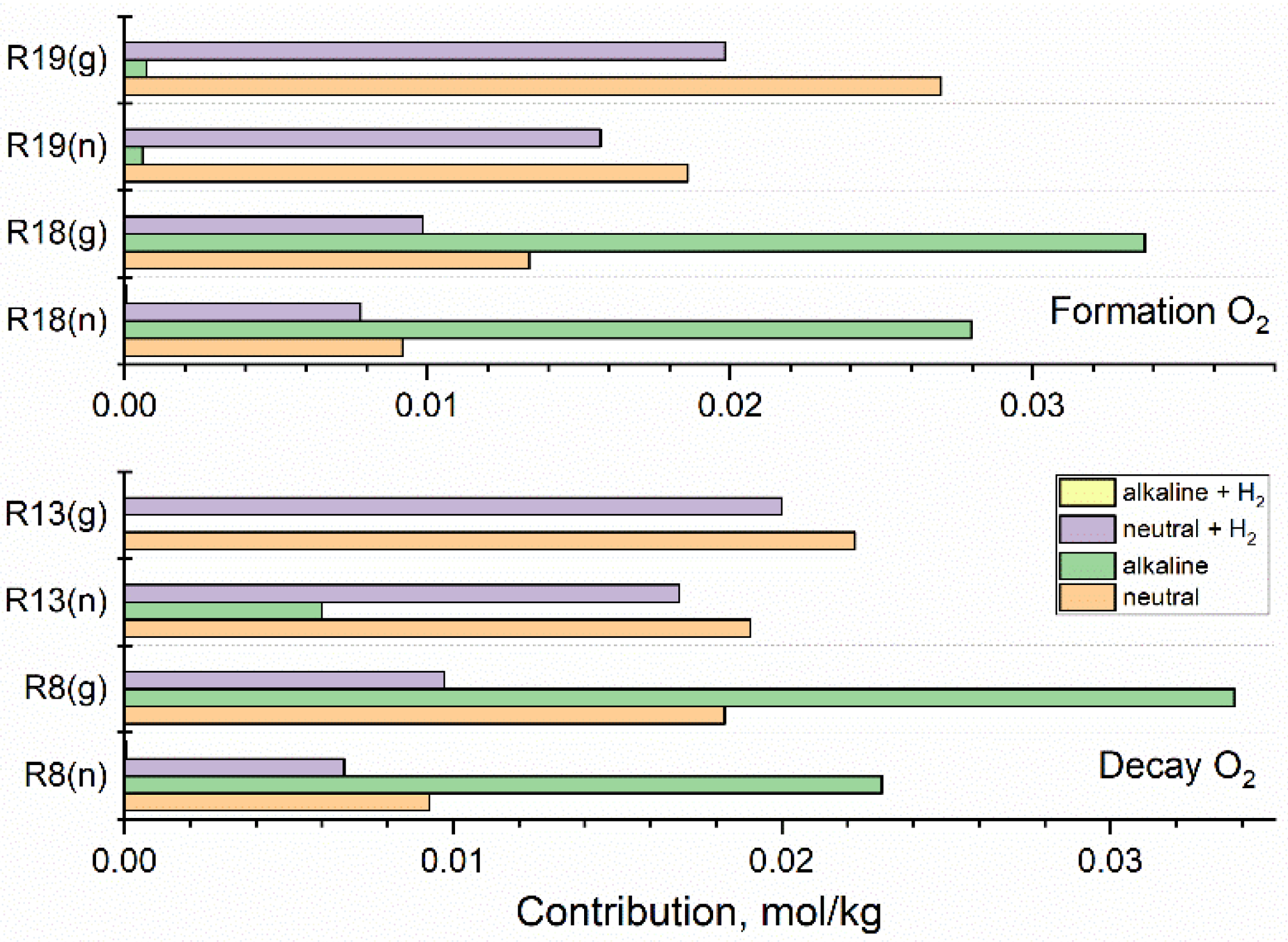
| Species i | Pi(g), M·s−1 | Pi(n), M·s−1 |
|---|---|---|
| eaq•– | 2.385⋅10−4 | 1.062⋅10−4 |
| H• | 5.970⋅10−5 | 5.455⋅10−05 |
| H+ | 2.837⋅10−4 | 1.453⋅10−4 |
| •OH | 3.564⋅10−4 | 2.730⋅10−4 |
| H2O2 | 1.866⋅10−5 | 3.201⋅10−5 |
| H2 | 4.776⋅10−5 | 8.895⋅10−5 |
| HO2• | 0 | 5.584⋅10−7 |
| OH− | 4.522⋅10−5 | 3.910⋅10−5 |
| -H2O | 3.937⋅10−4 | 3.387⋅10−4 |
| No. | Reaction | k (300 °C) | No. | Reaction | k (300 °C) |
|---|---|---|---|---|---|
| 1 1 | 6.06⋅106 | 30 1 | 5.69⋅1011 | ||
| 2 2 | 1.01⋅1011 | 31 1 | 2.52⋅101 | ||
| 3 2 | 1.80⋅1010 | 32 1 | 5.69⋅1011 | ||
| 4 2 | 4.39⋅1011 | 33 1 | 2.52⋅101 | ||
| 5 2 | 4.69⋅1011 | 34 1 | 1.36⋅1011 | ||
| 6 2 | 5.52⋅1010 | 35 1 | 1.76⋅108 | ||
| 7 2 | 2.73⋅1011 | 36 1 | 1.36⋅1011 | ||
| 8 2 | 2.49⋅1011 | 37 1 | 2.87⋅104 | ||
| 9 1 | 1.61⋅1011 | 38 1 | 7.16⋅1011 | ||
| 10 3 | 2.15⋅1011 | 39 1 | 1.65⋅105 | ||
| 11 2 | 2.46⋅1011 | 40 2 | 2.26⋅1010 | ||
| 12 2 | 1.29⋅109 | 41 2 | 1.16⋅103 | ||
| 13 2 | 1.11⋅1011 | 42 4 | 3.04⋅104 | ||
| 14 3 | 3.31⋅1011 | 43 2 | 1.15⋅109 | ||
| 15 1 | 2.14⋅1011 | 44 1 | 8.18⋅1010 | ||
| 16 2 | 2.73⋅1011 | 45 3 | 1.24⋅1011 | ||
| 17 2 | 4.35⋅108 | 46 1 | 8.18⋅1010 | ||
| 18 2 | 2.07⋅1011 | 47 1 | 8.76⋅1010 | ||
| 19 2 | 7.48⋅1010 | 48 1 | 1.55⋅109 | ||
| 20 2 | 4.51⋅107 | 49 1 | 3.26⋅1010 | ||
| 21 3 | 4.31⋅108 | 50 1 | 1.99⋅107 | ||
| 22 1 | 3.78⋅10−2 | 51 3 | 2.98⋅1011 | ||
| 23 1 | 3.78⋅10−2 | 52 3 | 5.79⋅1010 | ||
| 24 1 | 1.13⋅1012 | 53 5 | 7.12⋅108 | ||
| 25 1 | 6.52⋅10−2 | 54 3 | 4.31⋅108 | ||
| 26 1 | 5.69⋅1011 | 55 3 | 1.02⋅10−2 | ||
| 27 1 | 1.55⋅105 | 56 3 | 8.28⋅1010 | ||
| 28 1 | 1.36⋅1011 | 57 6 | 1.99⋅1011 | ||
| 29 1 | 1.76⋅108 |
| Oxidant/Solution | 1 kGy·s−1 Neutron γ-Radiolysis | 10 kGy·s−1 Neutron γ-Radiolysis |
|---|---|---|
| H2O2/neutral | 8.8·100 3.1·100 | 4.2·100 2.4·100 |
| H2O2/alkaline | 8.5·102 1.4·102 | 6.5·102 1.0·102 |
| O2/neutral | 4.2·102 2.7·102 | 1.5·102 1.1·102 |
| O2/alkaline | 2.2·106 5.0·106 | 8.7·105 1.4·106 |
Publisher’s Note: MDPI stays neutral with regard to jurisdictional claims in published maps and institutional affiliations. |
© 2022 by the author. Licensee MDPI, Basel, Switzerland. This article is an open access article distributed under the terms and conditions of the Creative Commons Attribution (CC BY) license (https://creativecommons.org/licenses/by/4.0/).
Share and Cite
Swiatla-Wojcik, D. A Numerical Simulation of Radiation Chemistry for Controlling the Oxidising Environment in Water-Cooled Nuclear Power Reactors. Appl. Sci. 2022, 12, 947. https://doi.org/10.3390/app12030947
Swiatla-Wojcik D. A Numerical Simulation of Radiation Chemistry for Controlling the Oxidising Environment in Water-Cooled Nuclear Power Reactors. Applied Sciences. 2022; 12(3):947. https://doi.org/10.3390/app12030947
Chicago/Turabian StyleSwiatla-Wojcik, Dorota. 2022. "A Numerical Simulation of Radiation Chemistry for Controlling the Oxidising Environment in Water-Cooled Nuclear Power Reactors" Applied Sciences 12, no. 3: 947. https://doi.org/10.3390/app12030947






